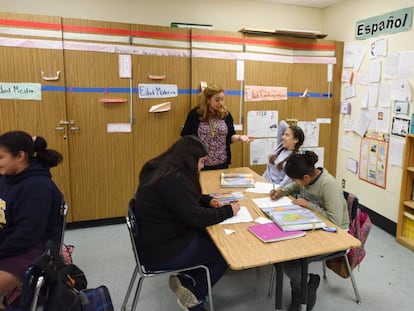Could this technology replace the need to learn languages?
The boom in instant-translation devices has many translators and interpreters concerned

Language barriers may no longer be a problem thanks to Travis the Translator, a new device capable of translating 80 languages in real time.
And with more than 42,500 people around the world forced to flee their homes each day, the device is set to provide much-needed assistance to NGOs that help those affected by the refugee crisis.
More than 200 devices have been given to Open Learning Exchange, a UN program aimed at improving access to basic education, as well as Movement on the Ground, an organization that supports refugees.
Language is much more than putting across a concrete idea
Sonia Pratt, Barcelona Autonomous University
But Travis the Translator has also raised concerns. Could it be an alternative to learning a language? Will devices like it replace professional translators and interpreters?
Travis the Translator, like Pilot or Google Pixel Buds, works on a very simple premise: two people who speak different languages put in an earpiece, which almost instantly translates the conversation.
The vice dean of Innovation and Technology in the Philology Department at Madrid’s Complutense University, Jorge Arús, says devices such as Travis the Translator are about making the speaker feel more secure: “They help get rid of the fear of speaking a foreign language in another country.”
Multinationals are also interested in Travis. “International companies such as IKEA have shown interest in our product; they think that it will help their staff at international meetings and on business trips,” said sources at the global company. Meanwhile, Google says that it has already sold Google Pixel Buds to companies based in Europe and South East Asia.
Google Translate has the level of comprehension of a six-year-old child ATRAE vice president Eugenia Arrés
Most instant translation devices cost around €200 but more affordable translation apps, such as Speak & translate, iTranslate and Skype Translator, are also gaining popularity.
Industry representatives argue their products are especially useful for travel, allowing users to find out about the local food and attractions. “If you’re going on a short trip, are you going to spend months learning a language you will use for a week? Most people don’t have time to do this,” say the makers of ili Wearable Translator.
For Sonia Prats, the director of language studies at the Autonomous University of Barcelona, “language is much more than putting across a concrete idea.” While Prats recognizes these systems could help people when traveling, she thinks they will never replace “the real need to communicate with other human beings.”
Arús doesn’t believe that instant translation devices are going to stop people from learning languages, instead “people could learn more having been exposed to the language by the device.”
But new technology continues to advance at vertiginous speeds. “We are in a boom era for artificial intelligence,” says Juan Salvador Castejón, spokesman for the general council of Spain’s IT engineering associations (CCII). The specialist in voice-recognition systems claims that technology has “evolved more quickly in the last year than in the last five.”
Only jobs where people provide extra value by making decisions or interpreting something that is non-technical will survive
Computer engineer Juan Salvador Castejón
Indeed, according to Alfonso Ureña, president of the Spanish society for natural language processing, “it is only a matter of time” before translation programs become perfect. But while voice-recognition technology is very advanced, it is not at the same level as human communication. The devices still make mistakes when it comes to context or translating phrases. Google translate for instance, can will literally translate “high five” to “cinco altos” – instead of the Spanish chócala.
But if instant-translation programs continue to improve at the same rate, some people expect to see big changes. For example, Salvador Vaticina, an interpreter in the European Parliament, could be replaced by one of these devices. But Eugenia Arrés, the vice president of Spanish Association of Audiovisual Translators (ATRAE), believes there’s nothing to worry about. She argues that the devices rely on artificial intelligence, which is “still in its infancy” today when it comes to translation.
“Google Translate has the level of comprehension of a six-year-old child. I don’t see these devices interpreting for businesses for the same reason that we don’t send text translated by Google Translate without revising it first,” she says.
Arrés has a different concern: privacy. She questions the degree to which translated recordings belong to device makers, and whether those firms are free to do what they like with them. “We have signed confidentiality agreements and at this point, I don’t think these devices will affect our work,” she adds.
That said, Arrés recognizes that the work of interpreters is likely to change just as has happened to translators, who spend an increasing amount of time editing rather than translating. Computer engineer Juan Salvador Castejón believes the best option for people in these industries is to build instant-translation devices: “Only jobs where people provide extra value by making decisions or interpreting something that is not simply a case of mechanical work will survive.”
The dubbing actress is convinced she falls into this category: ”In films, you don’t translate words, you translate feelings.” She also draws attention to the difference between simultaneous translation, which has has a slight delay, and synchronicity, where the words and mouth movements match perfectly. It is the same case with guides. Almudena Cencerrado, president of the Spanish Confederation of Tourists Guides, says earpieces can’t capture the experience: “It’s impossible to translate terminology or personal experiences without losing the human quality.”
English version by Melissa Kitson.
Tu suscripción se está usando en otro dispositivo
¿Quieres añadir otro usuario a tu suscripción?
Si continúas leyendo en este dispositivo, no se podrá leer en el otro.
FlechaTu suscripción se está usando en otro dispositivo y solo puedes acceder a EL PAÍS desde un dispositivo a la vez.
Si quieres compartir tu cuenta, cambia tu suscripción a la modalidad Premium, así podrás añadir otro usuario. Cada uno accederá con su propia cuenta de email, lo que os permitirá personalizar vuestra experiencia en EL PAÍS.
¿Tienes una suscripción de empresa? Accede aquí para contratar más cuentas.
En el caso de no saber quién está usando tu cuenta, te recomendamos cambiar tu contraseña aquí.
Si decides continuar compartiendo tu cuenta, este mensaje se mostrará en tu dispositivo y en el de la otra persona que está usando tu cuenta de forma indefinida, afectando a tu experiencia de lectura. Puedes consultar aquí los términos y condiciones de la suscripción digital.
More information
Archived In
Últimas noticias
The new victims of the Republican war on Obamacare: Millions hit by soaring health insurance premiums
A country divided on migrant rights: Some US states expand protections while others restrict them
Venezuela authorizes the release of another 87 political prisoners
There is as much life left to discover on planet Earth as that which is already known
Most viewed
- David King, chemist: ‘There are scientists studying how to cool the planet; nobody should stop these experiments from happening’
- Reinhard Genzel, Nobel laureate in physics: ‘One-minute videos will never give you the truth’
- Oona Chaplin: ‘I told James Cameron that I was living in a treehouse and starting a permaculture project with a friend’
- Sinaloa Cartel war is taking its toll on Los Chapitos
- The Interoceanic Train, the Mexican alternative to the Panama Canal











































